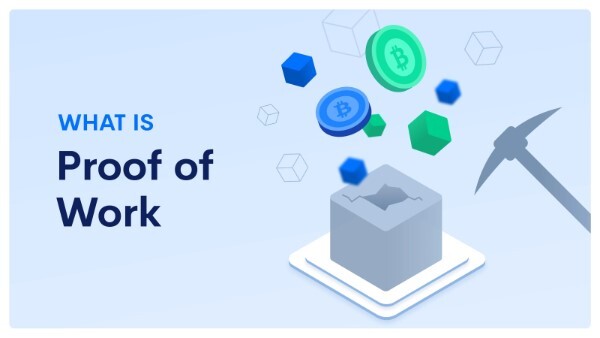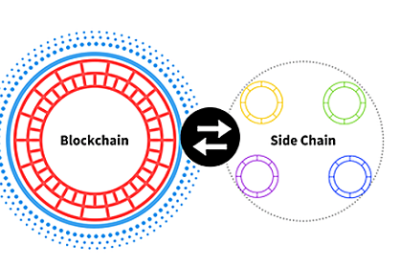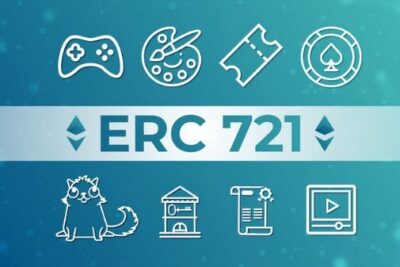

What Is Proof Of Work? What Does It Mean To Bitcoin And Cryptocurrency?
25 March 2022
When cryptocurrencies were first conceived, decentralization was a major goal. There has to be a means to verify transactions without the participation of financial institutions to achieve that. “Proof of Work” was one of the early solutions to the problem.
PoW is a kind of transaction addition to a cryptocurrency’s blockchain that relies on a person’s effort. Making a hash that matches the target hash for the current block is the work in this scenario, and it takes a long time. To add this block to the network, a cryptocurrency miner must first mine it.
Using a PoW as a consensus technique was employed by Bitcoin, the first cryptocurrency. As a safety net, it’s well-known, but it also has a significant environmental toll and is inefficient.
To properly grasp the currencies that employ PoW, you must first understand them. In addition, this might assist you to decide where to invest your cryptocurrency funds. A detailed description that bePAY analyzed of Proof of Work may be found by reading this post.
The History Of Proof Of Work Mechanism
Despite being the first adopter, Satoshi Nakamoto did not create the concept of PoW. So, who is the author of PoW? When was the first PoW concept conceived? The following are the key events in the formation of PoW:
The simplest form of Proof of Work (PoW) is expressed in the essay “Pricing via Processing or Combating Junk Mail” by scholars Cynthia Dwork and Moni Naor on the problem of defending against denial of service attacks. (DDoS, DDoS) and Spam Email issues.
- In the HashCash Whitepaper from 1997, Adam Back presented an anti-Double Spending Protection mechanism.
- Hal Finney applied the PoW concept to cryptocurrencies as a security solution in 2004, using a mechanism known as “Reusable Proof of Work.”
- Satoshi Nakamoto used Finney’s idea to develop a PoW consensus mechanism for Bitcoin in 2009.
- The PoW consensus mechanism has been a popular consensus mechanism in the cryptocurrency ecosystem since 2009.

History of PoW
What Is Proof Of Work Meaning?
Using a PoW system, such as sending spam emails or conducting denial of service attacks, is a viable but not insignificant way of discouraging the misuse of computational resources. In 2004, Hal Finney used the “reusable Proof of Work” concept to secure digital currency using the SHA-256 hashing method.
Finney’s PoW concept saw widespread adoption in 2009 with the launch of the Bitcoin currency. This decentralized consensus is made possible by several other cryptocurrencies that use Proof of Work as their foundation.
- A decentralized consensus technique called Proof of Work which forces network participants to spend time-solving an arbitrary mathematical challenge to avoid system abuse.
- Cryptocurrency mining relies heavily on PoW to verify transactions and mine new coins.
- PoW enables peer-to-peer transactions of Bitcoin and other cryptocurrencies without the requirement for a trusted third party, making them more secure.
- At-scale Proof of Work demands enormous quantities of power, and this power consumption only rises as more miners join the network.
- Another new consensus approach to replace PoW was Proof of Stake (PoS).
Bitcoin and Ethereum both use the Proof of Work mechanism to maintain their security. When it comes to digital currencies, there is usually one central authority or leader who keeps track of every user’s balance. Unlike with cryptocurrencies like Bitcoin, there isn’t a centralized figurehead in command of them. Without a central authority like a bank or government, virtual money would be worthless.

PoW definition
The “double-spending issue” which is more difficult to handle without a central figure, is addressed via Proof of Work. Users’ ability to double-spend their coins debases everyone else’s coins, causing the currency to become unpredictable and worthless as a result.
For online transactions, double-spending is a problem since digital activities are so simple to copy and paste, which makes it straightforward to send an email to many people.
Digital currency doubling is very difficult because of Proof of Work. It’s exactly what it sounds like: a “proof” that a considerable quantity of calculations has been performed.
>> Read also: Do you know what is Proof of Stake? Ultimate information for newbies
How Does The Proof Of Work Work?
A blockchain is a distributed ledger that records every Bitcoin transaction in the past, present, and future. The blocks that make up this blockchain are, of course, the name of the game. Each block will keep the recent transactions.
Adding additional blocks to the Bitcoin network necessitates Proof of Work. Miners, the participants in the ecosystem who do PoW, summon blocks to life. The network accepts a new block every 10 minutes when a miner produces a new winning PoW.
It is so difficult to find the winning Proof of Work that the only method to give the labor miners need to win Bitcoin is via pricey, specialized computers. If a miner correctly guesses a calculation, they will be rewarded with Bitcoin. The more Bitcoin they generate, the busier they are and the more money they make.

How does the Proof of Work work?
What precisely are the miners doing when they do their calculations? When mining Bitcoin, computers spit forth “hash,” which is a seemingly random string of letters and numbers, as a byproduct of their work.
For the miners, creating a hash that matches Bitcoin’s current “target” is their primary purpose. Creating a hash with a sufficient number of zeroes in front is required. It’s quite unlikely that you’ll see a string of zeros. As a result, it takes around 10 minutes on average for all of the miners in the globe to complete this task.
To reward the first person to complete their objective, they will get a number of Bitcoins. The Bitcoin protocol then generates a new value for the miners to hash, and the race to discover the winning Proof of Work begins all over again for the miners.
Proof Of Work Example
Bitcoin Proof Of Work Example
This is a Bitcoin Proof of Work example of how to protect the integrity of its blockchain. Once a Bitcoin transaction has been completed, it is gathered into a block and mined. A hash of the block is then generated using the Bitcoin Proof of Work mechanism. To create hashes, Bitcoin employs the algorithm SHA-256, which produces 64-character hashes.
For the first time, miners are racing against one other to produce a target that falls below the block’s hash. The winner gets to upload Bitcoin’s blockchain the newest transactions. Transaction fees and freshly produced coins are also given to them as Bitcoin incentives. The total number of Bitcoins in circulation will be limited to 21 million, but miners will continue to be compensated for their work even beyond that point.

Example of Proof of Work
Every 10 minutes, the Bitcoin Proof of Work algorithm adds a new block. This is accomplished by adjusting the difficulty of mining Bitcoin in relation to the rate at which blocks are being added. The hash calculations get more difficult if mining occurs at an excessive rate. They get less difficult when the pace slows.
Proof Of Work Has Both Benefits And Downsides
PoW has the following benefits and drawbacks:
Pros
- Security is at an excellent level.
- Slow transaction speeds and high costs make this system ineffective.
- Transactions may be verified in a decentralized manner.
Cons
- Use a lot of energy.
- Allows miners to be paid in cryptocurrency.
- Costly machinery is often required in mining.
>> You may also like: What is Proof of Authority and what does it solve for blockchain?
Proof Of Work Vs Proof Of Stake
It was the first consensus method for cryptocurrencies. Peercoin’s ($PPC) inception in 2012 marked the introduction of Proof of Stake, an alternative to Proof of Work. Depending on how many coins they have staked, or locked, to the network, it selects transaction validators.
Proof of Stake is more scalable than Proof of Work since it needs much less processing power. Proof of Stake cryptocurrencies use less energy and process transactions more rapidly, resulting in cheaper transaction costs. Staking Bitcoin is also a lot simpler to get started with than mining since there is no need for pricey equipment.
Proof of Work, on the other hand, is more secure. Proof of Stake has the potential to give parties with huge crypto holdings too much influence, while Proof of Work does not have this concern.

POW vs POS
One key distinction between the two consensus Proof of Work vs Proof of Stake procedures is the amount of energy they use. Proof of Stake blockchains enable networks to run with much-reduced resource usage since miners don’t have to spend power on duplicate operations (competing to solve the same problem).
Consensus techniques both include economic penalties for disrupting networks and thwarting malevolent actors. For miners that submit incorrect information or blocks, the punishment is the sunk cost of processing power, energy, and time.
Validators are financially motivated to perform in the best interest of the network under the Proof of Stake because of their staked crypto money. By accepting an invalid block, the staked money of the validator will be reduced. It is determined by the network how much of a validator may be sliced.
FAQs About Proof Of Work
What Is Proof Of Work Meaning?
In order to obtain agreements in a decentralized way and prevent bad actors from dominating the network, PoW needs nodes on a network to demonstrate that they have wasted computing power (i.e. work)
Why Is A Cryptocurrency Transaction Validated By Proof of Work?
There is no rhyme or reason to the labor. SHA-256 hashing methods are used for Bitcoin. A hashing round’s “winner,” on the other hand, is the one who collects and records transactions from a mempool into the next block. Since everyone on the network has a chance to win based on their contributions, it encourages everyone to be honest and record only legitimate transactions.

FAQs about PoW
Why Is Proof Of Work Necessary For Cryptocurrencies?
By their nature, blockchains like Bitcoin networks are distributed and peer-to-peer, therefore consensus and security are issues that must be addressed somehow. Proof of Work is an example of a mechanism that makes it prohibitively expensive to overrun the network.
Aside from the more resource-intensive Proof of Stake and Proof of burn, there are several less resource-intensive verification procedures. The network and the information it contains are at risk if no safeguards are in place to prevent unauthorized access or theft.
Final Thoughts
To guarantee that new blocks are added to the blockchain, a consensus process known as Proof of Work ensures that miners do a significant amount of computational work to establish that the new block is genuine.
Miners and other network members are less likely to attempt to compromise a cryptocurrency’s blockchain when Proof of Work is required because of the considerable investment in resources required. There have been no double-spend attacks against Bitcoin, which has been functioning at a large scale for 12 years without a hitch.
Nevertheless, POW must use a significant quantity of power. Bitcoin’s detractors claim that this has too great an effect on the environment to warrant the increased security it provides over existing processes like Proof of Stake.

What Are Sidechains? In-depth Compared With Layer 2
10 June 2022
What Is Staking Crypto? – Complete Tutorial For Newbies
30 March 2022
Private Keys – The Crucial Elements To Save Your Fund
27 April 2022









